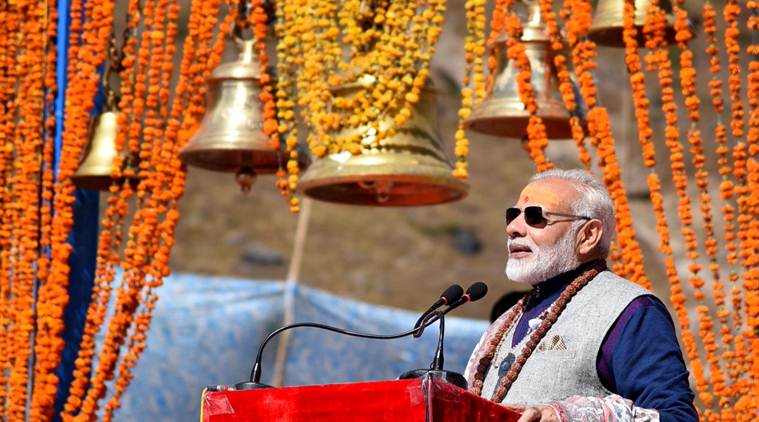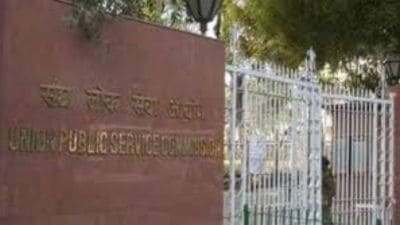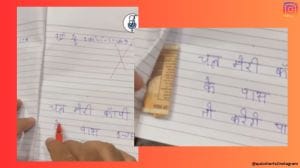- India
- International
Unlearnt lessons of 2013, as PM Modi promises new Kedarnath
Several elements of the PM’s speech tells us that the government has learnt no lessons. Many analysts have shown that the current unscientific and indiscriminate road building practices in Uttarakhand have contributed to significantly increasing disasters in the state.
 Prime Minister Narendra Modi in Kedarnath. (Source: Twitter/ @PMOIndia)
Prime Minister Narendra Modi in Kedarnath. (Source: Twitter/ @PMOIndia)
The central theme of Prime Minister Narendra Modi’s 40 minute-speech at the Himalayan pilgrimage centre of Kedarnath in Uttarakhand on Friday, was that we need to come out of the shadow of a disaster. It was to chart out a new design, development and reconstruction of the temple, the road, the banks of the river Mandakini and its tributary Saraswati and the memorial of Shankaracharya, which were affected by the 2013 disaster.
The PM took the opportunity to actually chart out a development road map, not only for Uttarakhand but the entire Himalayan region spanning from Kashmir to Sikkim. There were several welcome elements here, including the call for making the entire Himalayan region free of chemical agriculture and the move towards indigenous medicines. The narrative provided several chest-thumping moments for the speaker.
But typical of Modi ji, he left a lot unsaid. Most crucially, the cloud-burst remained unnamed, even though the PM used the word “disaster” several times. Not once did he say he was referring to the June 2013 floods that devastated Uttarakhand, when or why or what happened, the kind of factors that played a role, or what lessons, if any, had been learnt. It has been since agreed, both by top government bureaucrats as well as the US Geological Survey that climate change played a major role in the floods.
So the question : Is it even possible to get out of the shadow of the disaster without understanding it?
The truth is, that four years after the floods, we do not have a single comprehensive document that provides an overview of what happened at the disaster site or what we should have learnt from the unprecedented rainfall, floods, landslides that followed. As many as 6000 people lost their lives – that is the official figure – but the truth is that so many more did. In any other country there would have been several official reports, studies and reviews undertaken to study the various dimensions of the disaster and what needs to be done to reduce the proportions of the damage.

Several elements of the PM’s speech tells us that the government has learnt no lessons. For example, the PM laid the foundation stone for the widening of the road to Kedarnath. Many analysts, including well known senior geologist Prof K S Valdiya, have shown that the current unscientific and indiscriminate road building practices in Uttarakhand, which disregard hydrology, need for cross-drainage, etc, have contributed to significantly increasing the proportions of disasters in the state. The state government’s Disaster Management and Mitigation Centre has warned through several reports, some even before June 2013, that the use of explosives in development activities in Uttarakhand should be banned. But explosives are openly used even today in road building in Uttarakhand.
The PM proudly mentioned that this year over 4.5 lakh pilgrims have visited Kedarnath, and next year, he assured his audience, the number won’t be less than 10 lakhs. But troubling questions about the carrying capacity of the fragile Himalayan ecology, especially in the wake of the floods, have been raised by several experts. For example, no one had any clue how many pilgrims were present where, when the disaster struck. There is so much we can learn from our neighbor Bhutan about regulating the number of tourists to achieve sustainable development and a greater happiness index.
The prime minister also talked about the hydropower potential of Uttarakhand. But following the 2013 disaster, on August 13, 2013, the Supreme Court had directed the government to set up a committee to review the role of existing and under construction hydropower projects in the disaster. The multi-disciplinary committee headed by Ravi Chopra, set up by the Union Ministry of Environment and Forests (MoEF), showed clearly that the construction and operation of hydropower projects had increased the proportions of the disaster. In August 2016, the National Green Tribunal ordered the company operating the 330 MW Srinagar Hydropower project to pay Rs 9.26 crore in compensation to the people affected by the project.
Unfortunately, there have been a series of attempts to dilute the implementation of the Ravi Chopra committee recommendations, to the extent that only 24 hydropower projects now fall within its ambit. These projects were, in fact, had been ordered scrapped by the government’s Wildlife Institute of India even before the June 2013 disaster. But since the BJP came to power, the Prime Minister’s office has been trying to get even these 24 projects restarted. It is only because of contradictions between the changing stands of the judiciary and the ministries of environment & forests and water resources that these projects are still stalled.
The biggest hydropower project that Modi government is pushing in Uttarakhand is the proposed 5040 MW Pancheshwar multipurpose project on the Mahakali river (called the Sharda in India, part of Ganga basin) along the India-Nepal border. The project involves the construction of a much bigger dam than the controversial Tehri dam, in an area that is seismically more active, and more vulnerable to landslides, flash floods and geological uncertainties. Seismic energy has been building up along this Indo-Nepal border area for several decades, without any release, and seismologists have been predicting that the built up energy can lead to a quake of magnitude 8 or even 8.5 on Richter scale.
Environment Clearance for the Pancheshwar is on the agenda for the MoEF’s Expert Appraisal Committee on River Valley Projects for its meeting on Tuesday, October 24. The project is already hugely controversial, with a worse than usually dishonest Environment Impact Assessment. Public hearings for the project in Almora, Pithoragarh and Champawat districts were held in complete violation of most statutory norms, and had such huge presence of armed police personnel that the local people had to stand outside the hall. Most people critical of the project were not even allowed to speak.
The project is controversial even in Nepal. The Mahakali agreement with the Pancheshwar project as its centre-piece was signed in February 1996, but there is not even an agreement for a Detailed Project Report over 21 years later. Nepal hopes to sell power generated from its 50% share of installed capacity to power-surplus India. But the over Rs 50,000 crore project is expected to generate less than 2 Million Units electricity per MW installed capacity, which means the cost of power won’t be less than Rs 8 per unit. This makes the project economically unviable even at current prices, when power is rarely traded above Rs 3 per unit in recent years at power exchanges in India.
Piyush Goyal, till recently India’s Power Minister, has repeatedly told the Parliament that over 11 000 MW of hydropower capacity remains stranded for reasons of non viability. It’s a mystery why the government pushing such a project in fragile Himalayas.
Bholenath or Shiva, the presiding deity of Pancheshwar temple, is also the presiding deity of Kedarnath. The prime minister has a remarkable capacity to connect with his audience. At Kedarnath, he started his address with the chanting of the Jai Bholenath slogan. But we may well remember that the deity, as his attire declares, is closer to nature and rivers than possibly any other god, and cannot be fooled forever despite the name we have given him.
40 Years Ago
EXPRESS OPINION
More Explained
Apr 16: Latest News
- 01
- 02
- 03
- 04
- 05









































